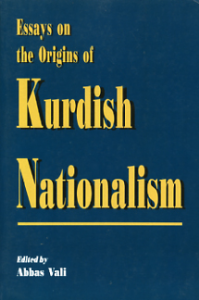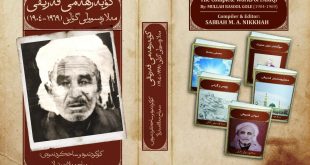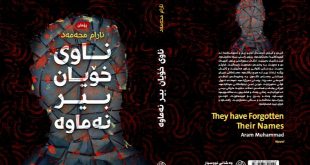
Essays on the Origins of Kurdish Nationalism

Michael M. Gunter
The author has successfully woven together in a limited space the evolution of Kurdish national identity during the waning days of the Ottoman Empire. This book must be read by all those who may be interested in the origins of the Kurdish national movement.
Mohammed M.A. Ahmed Ahmed
Foundation For Kurdish Studies
Essays on the Origins of Kurdish Nationalism, edited by ABBAS VALI. Costa Mesa, CA: Mazda Publishers, 2003. 234 pages. US$25.00 (Paper) ISBN 1-56859-142-X
Abbas Vali has collected a most important set of pioneering, theoretical essays on the origins and development of Kurdish nationalism. Interestingly, each essayist employs different methodological and theoretical approaches and thus presents strikingly opposing interpretations regarding the antiquity or modernity of the Kurdish nation and its nationalism.
The two essays by Hamit Bozarslan and single ones by Martin van Bruinessen and Nelida Fuccaro represent constructivist interpretations of the origins of the Kurdish nation and nationalism. In other words, these three essayists see the Kurdish nation as a modern invention of contemporary Kurdish politics, or what Benedict Anderson has so perceptively referred to as an “imagined community.” Bozarslan’s first essay emphasizes the important role nationalist historical writing in Turkey played since 1918 in the development of the Kurdish nation and national identity, while identifying five periods in this process. The “invention of national symbols [such as Kawa the blacksmith or the Newroz national holiday] as founding elements of Kurdish historiography compensated for the absence of history writing” (p. 26).
Bozarslan’s second chapter elaborates on two early periods of this political development: The period from 1919-21 when the traditional Kurdish religious and tribal elites left nationalist developments to the nascent Kurdish urban elite, and the period which occurred after the creation of the modern Turkish Republic in 1923 when the traditional elite became the leaders of Kurdish nationalism in a failed effort to stem the centralizing and secularizing efforts of the new Kemalist state. He suggests that two significant factors preventing Kurdish nationalism from “exerting real influence” during the first period were “the ideal of Islamic fraternity, and the fear of the establishment of an Armenian state” (p. 165). However, “the proclamation of the Kemalist Republic in 1923 meant the end of…the Ottoman tacit contract between centre and peripheries [and]…to a large extent explains the changing attitude of the Kurdish traditional dignitaries, and their participation in the subsequent revolts” (Ibid.).
Martin van Bruinessen disputes the oft-made claim that Ahmadi Khani’s 17th century epic Mam u Zin was a precursor of modern Kurdish nationalism. He argues that neither the political nor socio-economic prerequisites existed in 17th century Kurdistan for any notion of the nation to exist, because tribes were the main collectivity with which Kurds identified. “In general, people did not identify themselves as ethnic groups or nations in the way that people nowadays do” (p. 44). The absence of what Benedict Anderson has termed “print capitalism” also helped prevent any concept of the nation. Like Bozarslan, therefore, Bruinessen argues that Kurdish nationalism only began to develop in the final decades of the Ottoman period.
Nelida Fuccaro examines the historical development of Kurdish nationalism in Syria during the mandate period under the French in the 1920s and 1930s. The transnational Khoybun Party formed in 1927 and influenced by Kurdish as well as Armenian political and cultural forces played a key role in this development. Although Khoybun failed in its armed movement on Mount Ararat, it still “had a lasting effect on the subsequent development of Kurdish nationalist consciousness” (pp. 205-6). Fuccaro’s essay also analyzes the cultural role the Kurdish journal Hawar played in the 1930s after the failure of armed conflict, and the activities of the Badir Khan family and Hajo Agha of the Haverkan tribal confederation. The continuing importance of primordial tribal and religious loyalties, however, not only impeded the spread of Kurdish nationalism, but also opened it up to intervention and manipulation by competing Arab nationalist forces in Syria.
Amir Hassanpour’s theoretical approach represents the opposing primordial interpretation of the origin and development of Kurdish nationalism. Unlike the other essayists, Hassanpour sees the Kurdish nation as already in existence for hundreds of years and eventually leading to the development of modern Kurdish nationalism. Specifically, Hassanpour argues that Sharaf Khan’s Sharafname—an erudite history of the rulers of Kurdistan compiled at the end of the 16th century—and Ahmadi Khani’s Kurdish national epic Mam u Zin written in the 17th century mark the historical origin of Kurdish nationalism. “Sharaf Khan’s work demonstrates a conscious effort to assert Kurdish statehood” (p. 112). Hassanpour also states that “the first cartographic appearance of Kurdistan was in Ali Kashghari’s map of 1076” (p. 114n).
Hassanpour views these developments through a Marxist lens of social classes progressing through feudal and bourgeois nationalism, while also emphasizing the importance of the Kurdish emirates, which existed up to the middle of the 19th century as autonomous political entities. He refers to the 19th century Kurdish author Haji Qadir Koyi as “next to [Ahmadi] Khani …the second apostle of Kurdayeti [Kurdish nationalism]” (p. 130), and illustrates how Koyi took an “uncompromising stance against the backwardness of traditional Kurdish society” (p. 133).
In his essay, Abbas Vali, the editor of the entire collection, takes issue with Hassanpour by maintaining that “Kurdish nationalist historical discourse is a product of modernity, following the emergence of centralized territorial states in Turkey, Iran and Iraq” (p. 97). Vali adopts a more eclectic constructivist approach by attempting to identify the beginnings rather than origins of Kurdish nationalism. By this choice of terms, Vali means there is no uniform history or inviolable identity that may be discovered in historical origins. “The historical past, in this theoretical perspective, does not exist in the present and cannot secretly animate it….Studies of the past therefore start from and return to the present” (p. 11). Vali’s difficult theoretical and philosophical style of writing may prove challenging to some readers.
The combined product of all of these essays will help raise nascent Kurdish studies to an academic level worthy of serious scholarly attention. Although Mulla Mustafa Barzani was not one of the “religious leaders in Kurdish nationalist movements” (p. 83), as Vali claims, the reader must compliment him for his able work in compiling this important collection of essays. This is not a tome to be taken or read lightly.
Michael M. Gunter
Tennessee Technological University
 خانە کتاب كُردی
خانە کتاب كُردی


